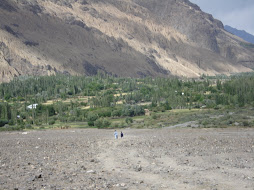By Salman Rashid
Hayward knew once he had explored the Darkot Pass at the head of this valley and made it safely into the Pamirs over the Broghal, officialdom would come clamouring to his support. Then, as now, there was no dearth of men eager to bask in another man’s glory
Between the beginning of the 19TH century and well into the 20th, the two great imperial powers of the day played what was called the Great Game. The name, coined by Arthur Connolly, a Scottish captain in the service of the East India Company, was the euphemism for the struggle for the control of Asia by Britain and Russia. In June 1842, Connolly gave up his ghost in the town square of Bokhara to the executioner’s sword. But the Great Game lived on; sometimes chivalrous, mostly deadly.
By the time the last proponent had played out the final act of this lethal Game, death had brought immortality to many a man engaged in it. Among others, one was called George Whitaker Hayward. He died not very far from Gilgit and his remains today lie buried in the dappled sunshine of the Christian cemetery in that town. In 1990, I had hunted for his grave, but building material spilling over from an adjacent construction site had covered up the tombstone and I had come away thinking it had fallen victim to our insensitivity to history.
In Gilgit again in September 1994, I visited the graveyard and was surprised by the neat look it wore. The trees looked fresher, there was no building material, and the cemetery was spic and span. It was not difficult to notice Hayward’s tombstone among the few graves in this tiny walled in burial ground — only the inscription had fallen out of its place in the stele and had been fixed on the horizontal piece. Someone just before me had thoughtfully placed a small bouquet on the tomb.
It was about sundown and I was alone under the trees alive with birds. The tombstone reminded me that Hayward, too, was a Fellow of the Royal Geographical Society (RGS). I thought how I might have worked at the same desk where this first class explorer and surveyor may have planned his own last and fatal expedition almost a century and a half before me. My flesh crawled. I sat down and touched the tombstone and I could almost see George Hayward, the most pathetic of the Great Game heroes.
With RGS backing, Hayward explored the country around Kashgar before setting out to prove what he believed to be shortest route from Peshawar to the Pamirs: the trail over the 3700 metre high Broghal Pass in the extreme north of Chitral.
Meanwhile, he wrote a letter to The Pioneer, the most widely read English language newspaper of India of the day. In this he censured the Maharaja of Kashmir for gross atrocities committed in Yasin (west of Gilgit), of which he had heard from survivors themselves. The article made its way to the Maharaja who was incensed. To please the Maharaja and to avoid any unnecessary embarrassment, the Government of India drew away from Hayward and so too did his patron, RGS.
Despite the withdrawal of official support, Hayward arrived in Yasin on July 13, 1870 to pursue his Pamir Expedition. He knew once he had explored the Darkot Pass at the head of this valley and made it safely into the Pamirs over the Broghal, officialdom would come clamouring to his support. Then, as now, there was no dearth of men eager to bask in another man’s glory. But that was to be only when Hayward returned successful to India. It never was, because five days later Hayward was dead, hacked to pieces by the men of the chief of Yasin.
Few details of that grisly occurrence are known, making it one of the most abiding mysteries of the Great Game. Some say that that in Yasin, Hayward had a heated argument with the Chief, Mir Wali, on the question of the route he was to take to Broghal. Others allege that Mir Wali was taken over by greed when he noticed the valuable gifts the explorer was bearing for other overlords on the way. In the Orient things work strangely, and there is every possibility that the Maharaja of Kashmir, upset with Hayward over the matter of his correspondence with The Pioneer, may have connived with his erstwhile enemies from Yasin. Whatever it was, the truth has never been discovered.
Leaving Yasin and arriving at Darkot, two marches to the north, Hayward set up camp outside the village on a low hill by a stream. To this day the stream is known as Farang Bur — White Man’s Stream. It was the afternoon of July 17. Later that day he was surprised to learn that a party of armed men had arrived from Yasin. By exposing the Maharaja’s atrocities against these very people, Hayward believed, he had gained their favour and had no reason to fear violence at their hands. But even before the sun had set, Hayward had some inclination of impending treachery. This came from his servant who now told him that shortly before departure from Yasin, Mir Wali had incited him to desert. And so Hayward decided to remain awake through the night.
He forwent dinner and plied himself with tea as he sat alone in his tent writing by lamplight. On the table was a loaded revolver and across his knees lay his rifle. His camp slept. Outside there was no unusual sound. The night wore on peacefully until complacence took over. Just before dawn, the fatigue of the long vigil overcame him and Hayward put his head on the table to sleep. The men who had waited beyond the glow of his campfire were alert, however. They leapt into his camp; a short struggle followed and they were in control. Hayward was bound, a noose put around his neck and he and his servants were led into the forest.
It is said that Hayward tried to buy his freedom against the contents of his baggage. The men of Yasin pointed out to him that after killing him all that was anyway going to be theirs. Then, just as the first rays of the sun were beginning to light up the remote valley of Darkot, a single stroke of the sword beheaded Hayward, who believed that the shortest and easiest route to the Pamirs was over the Broghal Pass. Next went his servants and then his camp was looted.
Another account says that before he died he requested to be allowed to watch the sun come up over the mountains. And so with his hands bound behind his back, he walked to a small hillock and stood looking silently eastward. Done with his private ritual, he turned back and calmly said, ‘I am ready’. The sun, so far as George Whitaker Hayward was concerned, rose the last time on July 18, 1870.
Weeks later, Hayward’s body was recovered on the efforts of a British geologist working for the Maharaja of Kashmir. The burial took place in a small garden in Gilgit as soldiers fired three volleys for the departed explorer. It might have brought his spirit some peace to know that death — and not success, as he had hoped — had caused his re-adoption by RGS for the last line of the epitaph on the tomb in Gilgit reads, ‘This monument is erected to a gallant officer and accomplished traveller at the instance of the Royal Geographical Society.’--Courtesy Daily Times
Saturday, September 6, 2008
Subscribe to:
Post Comments (Atom)
Awesome and rugged

Beauty of Chitral

Kishmanja, a beautiful village in Yarkhun valley
Lush green

DIZG: threatened by floods

The legendary village of Ayun in Chitral

On way to Bumburet
Dizg, Yarkhun

Blog Archive
-
▼
2008
(195)
-
▼
September
(60)
- The wishy-washy Ruet Committee
- Leaseing of resources to outsiders slammed
- Transparency in zakat card distribution stressed
- Tributes paid to martyred policemen
- Hiring of outsiders as grain supervisors opposed
- Most schools in Chitral without science teachers
- Boy killed, mother injured in accident
- PTCL phones partially restored
- TOURISM IN THE DOLDRUMS
- Road to Yarkhun valley reopens after five months
- Hotel Haut Monde
- Chitrali injured in Marriott blast improving
- Jashn-i-Chitral could have attracted terrorists, n...
- Five killed, one injured in accident
- Eight feared dead in Chitral accident
- Call to enhance Chitral border security
- MNA angry over non-release of uplift funds
- Car donated to DHQ hospital used as taxi by doctor
- Protest held in Chitral against price hike
- Bird hits Chitral-bound PIA plane
- Killed suicide bomber used fake Chitrali identity
- Chitral peace body vows to keep militants away
- Body of Marriott blast victim buried in Bang
- Students suffer due to lack of hostels
- Cancellation of Jashn-i-Chitral justified
- Over 75pc work on Lowari tunnel access roads compl...
- Two tribes in Bumburet end feud; ox goes to the Sh...
- Chitral residents reject raise in water rates
- Chitrali victim of Marriott blast dies
- Chitrali injued in Marriott blast critical
- Chitralis the music lovers
- Floods can wipe out Kalash valley, say elders
- Woman released on HR activists' intervention
- Boy commits suicide in Kosht
- Three Chitralis injured in Marriott blast
- Chitralis working in Marriott Hotel are safe
- Freezing of Chitral's uplift funds criticised
- Suicide blast at Marriott Islamabad
- Funds for Yarkhun bridge released
- Decision to cancel Chitral festival slammed
- Flashfloods damage schools in Reshun
- MNA's decision to join PPP hailed
- Jashn-i-Chitral cancelled
- British paraglider injured in Chitral
- Two-month marble mosaic training workshop begins
- HR body elects office-bearers for Mastuj
- Call to open passport office in Chitral
- <!--google_ad_client = "pub-2976157137802820";/* 7...
- MPA seeks more uplift funds for Mastuj area
- Public library still a far cry in Chitral
- Chitral farmers provided incentives
- PPP Chitral congratulates Zardari
- Five-day Jashn-i-Chitral from Oct 11
- Who killed 'em?
- Trophy hunting becomes vital conservation tool
- Asif Zardari elected President of Pakistan
- Kalash village threatened by floods
- Death on the Farang Bur
- Marble city planned in Chitral
- Call to appoint doctors in health centres of Mastuj
-
▼
September
(60)
About Me

- Zar Alam Khan Razakhel
- Village Dizg, Yarkhun valley, Chitral, Pakistan
- I blog at http://chitraltoday.net (ChitralToday) about Chitral, its people, culture, traditions and issues. I have been writing about Chitral since 2000. Chitral is a scenic valley in the extreme north-west of Pakistan.
No comments:
Post a Comment